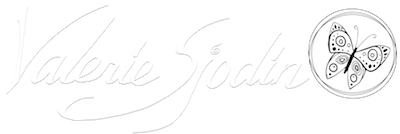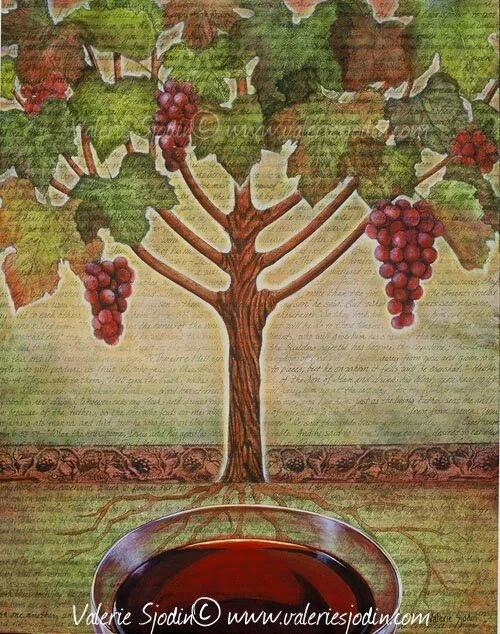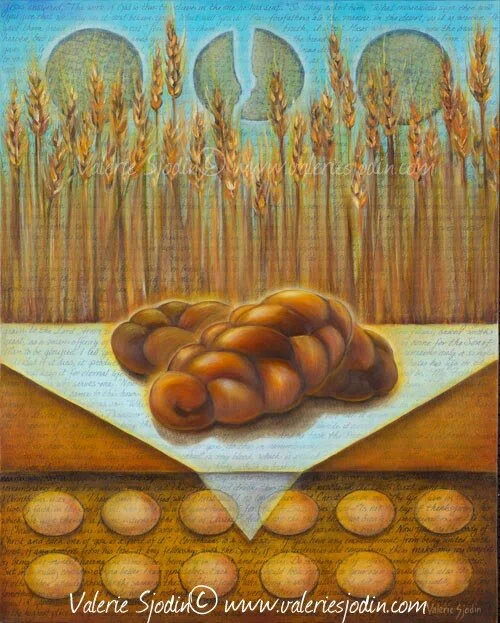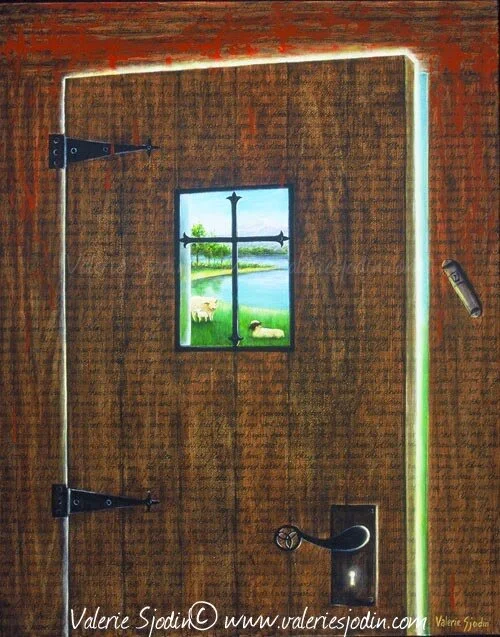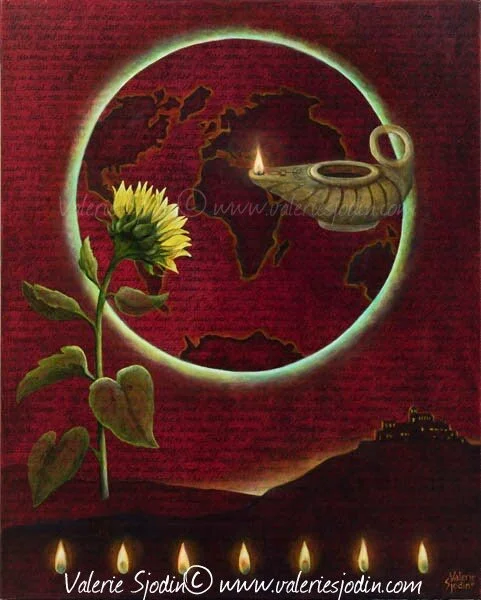"I AM" Paintings presented and explained
These seven paintings are the "I AM" series, also called "Presenting the Light". They were the subject of my BFA thesis and included here is the meaning of the symbolism and Scripture used as the basis of the work. I would like to thank Mark Morse who consulted with me and edited much of the text written from my thesis paper. I recently went over it, reworked it a bit, and am posting it here. Currently the series is hanging at True Vine Fellowship Church. They are hosting a gathering "An Evening with the Artist" where I will be talking and sharing about the paintings, and you are invited. It is on Wednesday, June 1, 2011, at 6:30-8:00 pm. Address:118 NE 4th Street, McMinnville. I'd love to see you there. Thank you for visiting.
"I AM the True Vine"
image copyright and text Valerie Sjodin 2011
The grapevine both in first century Judaism and todaysymbolizes both the source of life, and its celebration. I included the grapevine border for aesthetic reasons and because it is a common symbol in may cultures--found in ornament and architecture--of fruitfulness. The grapevine here references the menorah with seven branches. The roots reach deeper to draw from the well of living water.
The vine takes the nourishment from the water and soil, channeling it through the branches to the fruit. In describing himself is the true vine, Yeshua helps them understand that He is their source of life and nourishment. His followers are the branches intended to produce fruit. A branch only produces fruit when attached to the vine.
It’s fruit is shared in community and fellowship. Yeshua transformed water into wine at a Jewish wedding celebration.
Its deeper color is felt when Yeshua describes the wine of his last meal with His disciples as His blood,
“drink from it,
all of you. This is my blood of the covenant, which is
poured out for may for the forgiveness of sins.”
"I am the vine; you are the branches.
If a man remains in me and I in him,
he will bear much fruit;
apart from me you can do nothing."
John 15:5 NIV
Biblical text in the background:
John 15:1-16, Galatians 5:22-25,
John 2:1-11,
Matthew 21:33-44, John 6:53-59, Luke 22:14-18,
Matthew 26:26-29, I Corinthians 11:24-26,
I Corinthians 10:16-17, 12:27, Ephesians 2:14-18,
I John 1:7, 2:2
"I AM the Bread of Life"
Image & text copyright Valerie Sjodin 2011
Twelve loaves of shew bread represent Jewish practice. In the Jewish temple twelve pieces of bread were placed upon a golden table representing each of Israel’s tribes. They were placed in two rows signifying the Jews and Gentiles (or, all of humanity). In the painting, they remind us that Jesus came as the bread of life for Jews and Gentiles, everyone. The two loaves of challah bread represent the Pentecost festival. On the 50th day after the first sheaf of wheat was raised at
harvest time, two loaves of leavened bread were placed on the shew bread table instead of the twelve unleaven loaves. The two symbolize humanity’s sinfulness (the leaven) and hope of a redeemer.
In Messianic and Christian celebrations the three pieces of matzah represent the Trinity: Father, Son (Yeshua), and Holy Spirit. The second matzah, representing Yeshua, is broken in two and the larger broken piece is called the “afikomen” meaning after supper, or dessert. It is wrapped and hidden in the house to be found later after the Passover meal.
Yeshus’s broken body was buried (hidden) in a tomb and was raised from the dead three days after the Passover.
With his disciples Yeshua took the second piece of matzah bread and, in anticipation of his death, broke it saying,
“Take, eat: this is My body, which is broken for you.”
"For the bread of God is he who comes down from heaven and gives life to the world….
I am the bread of life. He who comes to me will never go hungry,
and he who believes in me will never be thirsty."
John 6:33,35 NIV
Biblical text used in the background:
John 6:29-40, 44-51, 53-58; Hebrews 9:1-2, Leviticus 24:5-9, Exodus 34:21-22, Leviticus 23:15-17, John 12: 23-28, Luke 22:14-20, I Corinthians 11:24-26, Galatians 2: 20, I Corinthians 10:16-17, 12:27, Philippians 2:1-11.
"I AM the Door of the Sheep"
image and text copyright Valerie Sjodin 2011
This painting focuses on three powerful images, ‘blood,’ ‘sheep,’ and ‘door’ which represent God’s loving provision
for His people.
In the Torah is found the account of the Passover which began during the Jews’ captivity in Egypt. God instructed the Israelites to sacrifice an unblemished lamb, placing some of its blood on the doorposts and lintels of their houses. The angel of death went through Egypt and killed the firstborn of every household except those with the lamb’s blood. They were passed over because of their sacrifice and obedience.
In the New Testament, the sacrifice and obedience were performed by Christ. He is the sacrificial lamb
“who takes away the sin of the world.”
His obedience through the cross provides the way to peace and rest. While we are often
described as sheep, He alone is the sacrifice. We, are
recipients of the peace and rest found in His pasture (Psalm 23), for He is the “the good shepherd.” A good shepherd lays down his life for the sheep. He is the “door” keeping out the wolves and thieves. He is the shepherd who will not flee, defending his sheep unto death.
The door is open. This is Yeshua’s invitation to us to enter into the safety and redemption on the other side. The window is a glimpse of peace and rest in God’s pasture. The cross is the way to the peace.
"Truly, truly, I say to you, I am the door of the sheep…
If anyone enters through Me, he shall be saved
and shall go in and out, and find pasture."
John 10:7,9 NAS
Biblical text in the background:
Exodus 12:1-29, Psalm 121, Deuteronomy 6:4-9, 11:13-21, Psalm 84, Psalm 23,
John 1:29, 10:1-10, Hebrews 10:15-22, Matthew 7:7-8, 13-14, Revelation 3:20,
Psalm 118:13-14, 19-21, 28
"I AM the Light of the World"
image and text copyright Valerie Sjodin 2011
One of my painting teachers said that to show the lightest lights you must contrast it with the darkest darks. The challenge of this piece was showing light in the darkness while retaining the readability of the text. I began with a painted red ground and put a wash of Paynes gray over it. Then I wrote the text on top. The darker landscape shapes contrast with the “floating” objects. My hope was to create a sense of mystery and unity with the “floating” objects while contrasting it with the darker horizon and city on the hill giving the viewer a point of reference.
The globe represents the whole of humanity on earth, past, present, and future. The sunflower symbolizes the individual whose soul turns to the Light because the head of the sunflower will turn and follow the sun. It is also Yeshua, our example, coming to do only what the Father is doing. The oil lamp and the flame are a symbol of the dual nature of Jesus, fully human and fully divine. The flame is places on the globe over Israel representing the life of Christ on earth. The city on the hill is a picture of the verses in Matthew 5:14,16 “You are the light of the world. A city on a hill cannot be hidden... let your light shine before men, that they may see your good deeds and praise your Father in heaven.” It is a call to believers to live the kingdom of God. The seven flames at the base are symbolic of the light of God shining from the menorah: creation, the Jewish origin of Christianity, and the promise of eternal life.
"Jesus said, I am the light of the world.
Whoever follows me will never walk in darkness,
but will have the light of life."
John 8:12 NIV
Biblical text used in the background:
Genesis 1:1-4, Isaiah 42:5-7,16; Nehemiah 9:5-6, Psalm 89:14-16, 4:5-6, 27:1-2, 18:27,28; 36:5,7,9; 139:7-12, Matthew 4:15-17, John 1:1-14; John 8:12, 12:35-37, 44-46; 3:19-21, Luke 8:16-17, Matthew 5:14-16, Ephesians 5:8-14, 1 Peter 2:9-10.
